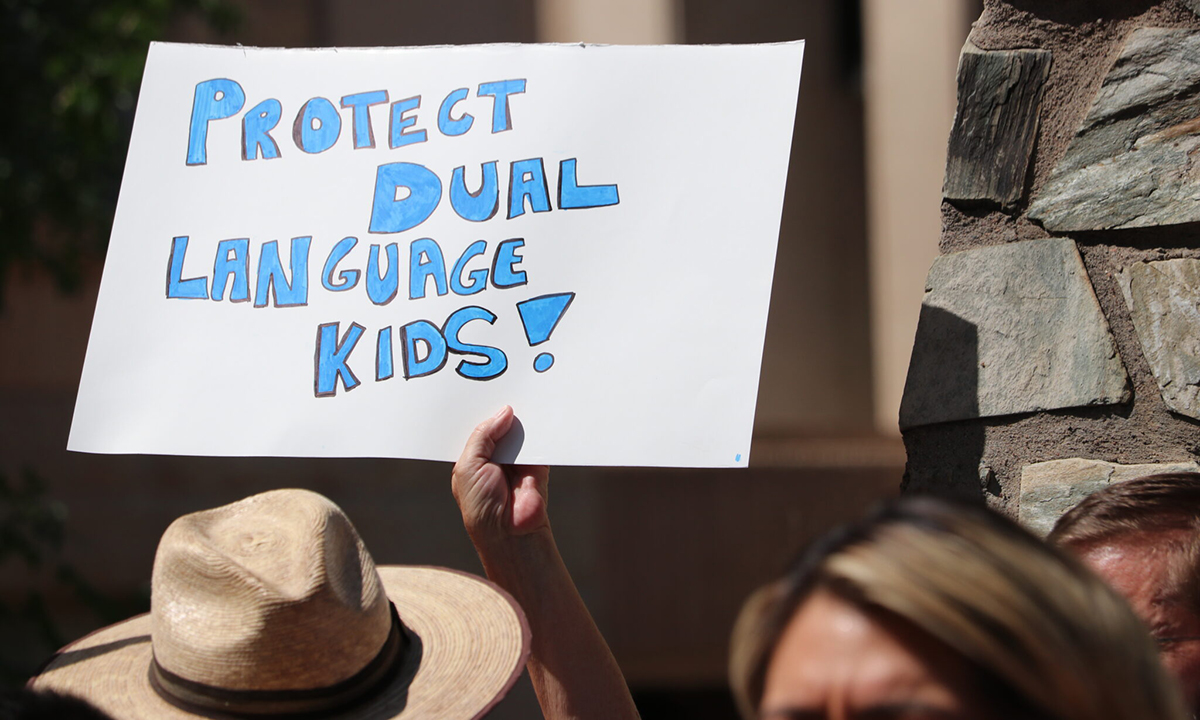Arizona Can’t Defund Dual Language Education Programs, State AG Says
Superintendent Tom Horne has threatened to withhold funding from schools that use the instructional model to teach English Language Learner students.

Get stories like this delivered straight to your inbox. Sign up for The 74 Newsletter
State Superintendent of Public Instruction Tom Horne doesn’t have the power to punish schools for using dual language instructional models, according to Attorney General Kris Mayes.
But this won’t be the end of the matter, as Horne is preparing to sue schools teaching students in two languages.
Last month, Horne, a Republican and long-time foe of bilingual education, threatened to withhold funding from schools using the 50-50 dual language model. The model is one of four instructional strategies approved by the Arizona State Board of Education in 2020 to teach students not yet proficient in English. Under it, students are taught in English for half of the school day and in their native language for the other half.
As many as 26 school districts across the state, including 110 schools, employ the 50-50 model and were poised to lose critical funds if they didn’t retire the teaching method. With the start of classes just weeks away, school officials and public education advocates sounded the alarm over the uncertainty sowed by Horne’s statements.
But on Monday, Mayes dismissed the threat to schools, saying Horne doesn’t have the legal authority to withhold state dollars or make any decisions about the model’s validity.
“The Superintendent’s and the (Arizona Department of Education’s) role…is limited to monitoring and referring school districts and charter schools to the Board,” Mayes wrote in a formal opinion issued in response to a request from Democratic legislators.
Mayes, a Democrat who was elected in 2022, concluded that Horne is responsible for overseeing and reporting on the implementation of English learner programs in Arizona, but no state law gives him the authority to take action against schools or decide the fate of certain programs.
The most a state superintendent can do, under state law, is compile reports on noncompliant schools and refer them to the State Board of Education. Only the State Board of Education has the power to modify or invalidate a teaching method. And until the board decides to eliminate the dual language model, Mayes said, it remains an option for schools seeking a way to teach their English language learner students.
At the heart of Horne’s criticism of dual language programs is that they violate the English-only standard set up in Proposition 203, a law overwhelmingly passed by Arizona voters in 2000. It prohibits teaching English learners in any language other than English until they’ve achieved proficiency. The only exception is for students whose parents fill out a yearly waiver allowing them to be taught in a bilingual program.
But four years ago, state lawmakers, alarmed over the dismal academic outlook of English learners, unanimously approved a law that gave the State Board of Education permission to branch out into new, research-backed teaching models. One of those was the dual language model that’s increasingly popular today.
Mayes points to the laws which govern English language learner programs as evidence that only the State Board of Education has the power, given by the legislature, to do away with a teaching model.
“The Board has sole statutory authority to delete or modify an SEI (Structured English Immersion) model,” she wrote. “Neither the Department nor the Superintendent has statutory authority to reject an SEI model approved by the Board or to declare its illegality. Nor does the Superintendent or the Department have authority to withhold monies from school districts or otherwise impose consequences on schools for utilizing the Dual Language Model.”
Mayes declined, however, to rule on the question of whether a conflict exists with the provisions of Prop. 203, writing that such a “fact-dependent analysis” is outside the scope of interpreting Arizona law in a formal opinion.
“This Office declines to attempt such a fact-dependent analysis in the context of an official request for an Opinion, which does not involve public hearings or other taking of evidence,” she wrote. “The Board has approved the Dual Language Model as a model of SEI instruction, and school districts and charter schools remain entitled to rely on that approval.”
Doug Nick, a spokesman for the Department of Education, which Horne leads, said the next step is likely to take place in court.
“We are in the process of reviewing the opinion and we expect to deliver a court challenge,” he told the Mirror.
Shortly after Mayes issued her opinion, the State Board of Education affirmed that it would neither modify the teaching models currently in use across the state nor punish schools for implementing the 50/50 dual language method. Making any changes to currently approved teaching models or even eliminating them requires a majority vote of the board’s 11 members, which includes Horne.
“The Board will not be taking action to change the approved models,” Executive Director Sean Ross said in an emailed statement. “The Board will also not take action against schools for using the approved models.”
Arizona Mirror is part of States Newsroom, a network of news bureaus supported by grants and a coalition of donors as a 501c(3) public charity. Arizona Mirror maintains editorial independence. Contact Editor Jim Small for questions: [email protected]. Follow Arizona Mirror on Facebook and Twitter.
Get stories like these delivered straight to your inbox. Sign up for The 74 Newsletter

;)